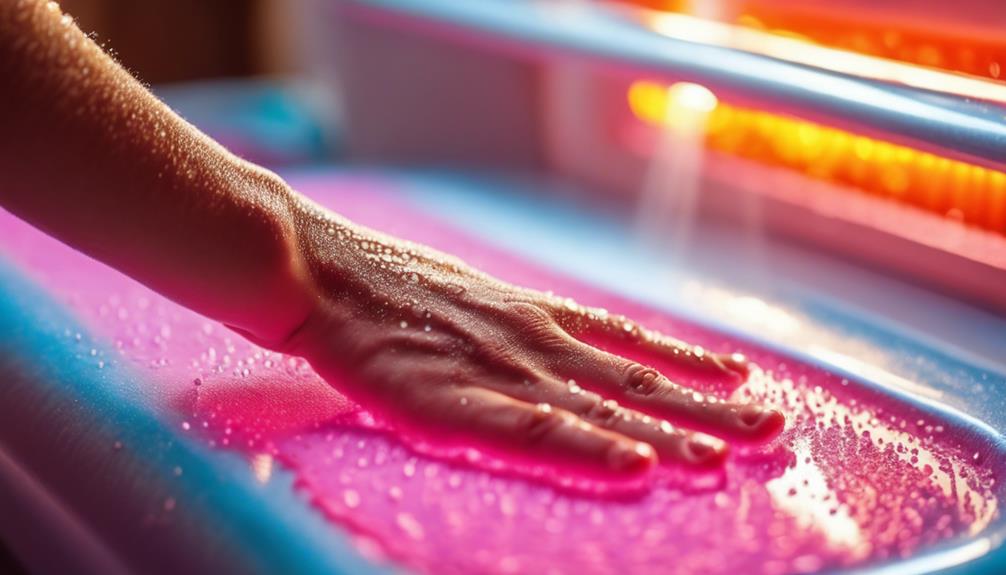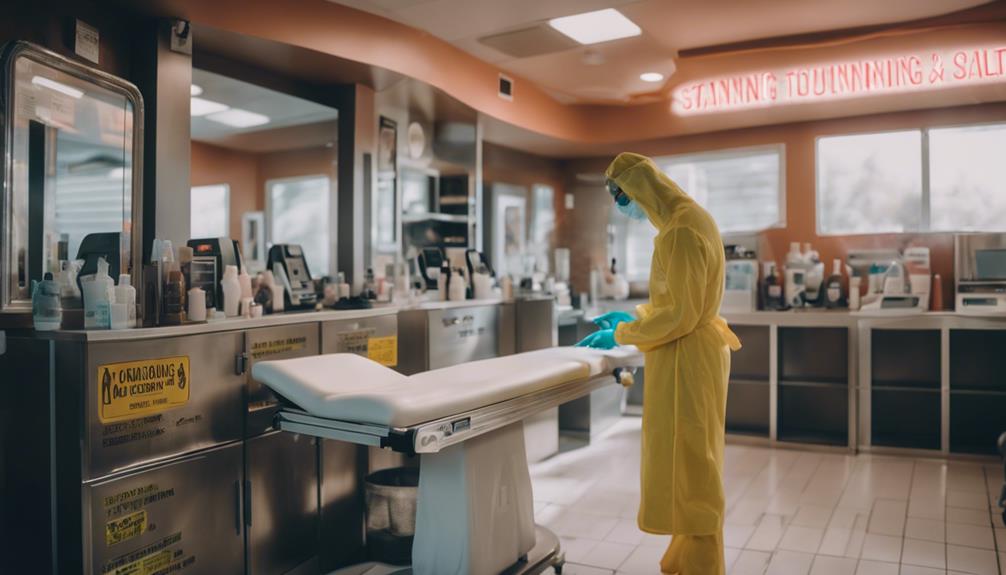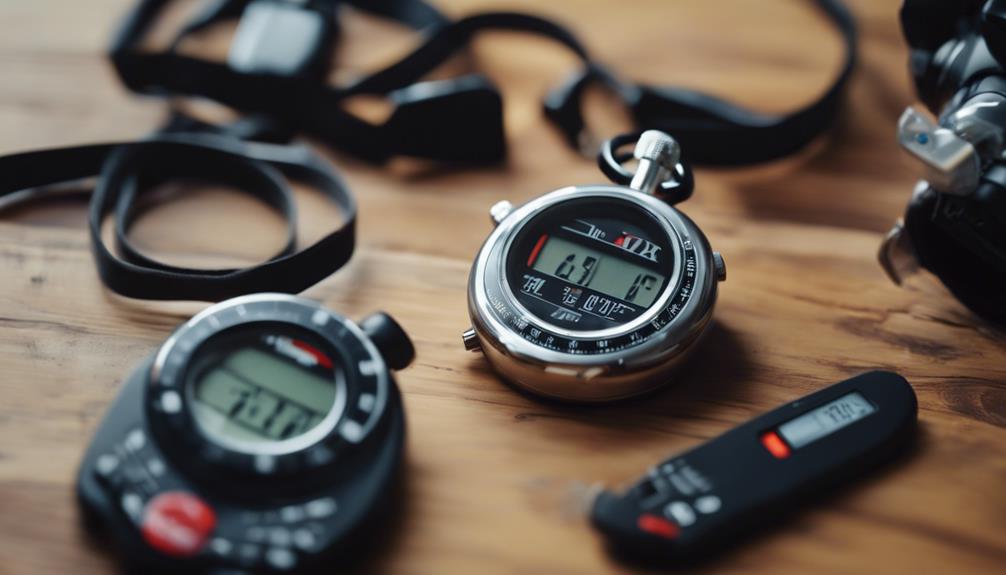To protect yourself from infections from tanning beds, it is important to prioritize cleanliness and hygiene. It is recommended to choose reputable salons that follow strict disinfection protocols. Make sure that tanning beds are cleaned and sanitized before each session. Utilize protective measures such as disposable sheets, high-quality tanning lotions, and FDA-approved goggles. Using antimicrobial lotions containing tea tree oil can also help reduce the risk of infection. Be mindful of potential health risks associated with tanning, such as skin infections and cancers. Additionally, establish a thorough post-tanning skincare routine to aid in skin recovery. For more advice on maintaining your tanning health, explore further insights.
Key Takeaways
- Inquire about the salon's sanitization procedures and ensure tanning beds are disinfected before each use to minimize infection risks.
- Always wear FDA-approved goggles to protect your eyes from harmful UV rays during tanning sessions.
- Use disposable sheets or towels on tanning beds to maintain hygiene and reduce bacterial exposure.
- Apply antimicrobial lotions containing tea tree oil or benzalkonium chloride before tanning to protect your skin.
Importance of Clean Facilities
Maintaining high cleanliness standards in tanning salons is crucial for minimizing the risk of infections and guaranteeing a safe tanning experience. Salons that prioritize hygiene actively disinfect tanning beds before each use, markedly reducing the likelihood of bacterial or fungal contamination.
Clients should avoid establishments that exhibit poor hygiene practices, as these can lead to serious health effects, including skin infections and increased risk of skin cancer. It is prudent to inquire about a salon's sanitization procedures to ascertain compliance with health standards.
Additionally, choosing facilities that combine tanning services with robust safety measures fosters a more secure environment. Staying informed about tanning bed cleanliness is imperative for safeguarding overall health while enjoying tanning services.
Protective Measures for Skin
How can individuals effectively protect their skin while using tanning beds?
To minimize risks, it is essential to employ protective barriers. Utilizing FDA-approved goggles specifically designed for tanning bed use is vital, ensuring they fit snugly to block harmful UV rays.
Moreover, disposable sheets or towels should be used to create a hygienic barrier on the tanning bed, safeguarding the skin from potential contamination. Wearing disposable undergarments can additionally enhance protection during sessions.
In addition, bringing personal towels or sheets can provide added comfort and hygiene. Regularly applying high-quality tanning lotions that hydrate the skin can also mitigate risks.
Antimicrobial Product Application

Incorporating antimicrobial products into the tanning process enhances skin protection and complements the hygiene measures already established through protective barriers. These products serve as an additional layer of defense against potential infections.
To maximize their effectiveness, consider the following steps:
- Apply antimicrobial lotions: Use products containing tea tree oil or benzalkonium chloride before tanning, ensuring the skin is clean and dry.
- Maintain routine: Regularly cleanse and moisturize your skin to support overall skin health and resilience.
- Consult professionals: Seek recommendations from dermatologists for suitable antimicrobial products tailored to your skin type.
While antimicrobial lotions are beneficial, they should not replace proper cleansing practices. Prioritize hygiene to safeguard against tanning bed infections effectively.
Health Risks Awareness
Understanding the health risks associated with tanning bed usage is essential for ensuring safe and responsible tanning practices. Tanning beds can harbor bacteria, increasing the risk of skin infections if proper hygiene is not observed. Additionally, exposure to UV rays may lead to skin damage and increase the likelihood of skin cancer. To mitigate these risks, it is vital to opt for clean facilities and adhere to recommended guidelines. The following table outlines key health risks and their implications:
| Health Risk | Implication |
|---|---|
| Skin Infections | Bacterial growth on skin |
| Skin Cancer | Increased risk with prolonged use |
| Premature Aging | Loss of elasticity and wrinkles |
| Eye Damage | Potential for UV-related issues |
| Immune System Impact | Compromised skin defenses |
General Tanning Best Practices

Adhering to general tanning best practices is essential for promoting skin health and minimizing the risks associated with tanning bed usage. Implementing effective strategies can greatly enhance your tanning experience while reducing potential health hazards.
Consider the following best practices:
- Use Quality Products: Apply high-quality tanning lotions that hydrate and protect your skin. Guarantee even application to cover all areas effectively.
- Maintain Cleanliness: Always clean the tanning bed surfaces before use to eliminate germs and bacteria, guaranteeing a hygienic environment.
- Protect Your Eyes: Utilize FDA-approved goggles specifically designed for tanning to safeguard your eyes from harmful UV rays.
Choosing a Tanning Salon
Selecting a reputable tanning salon is essential for ensuring a safe and hygienic tanning experience. When choosing a salon, prioritize those that demonstrate strict cleanliness protocols, including regular disinfection of tanning beds before each use.
Inquire about the salon's maintenance practices and the frequency of sanitation procedures to minimize the risk of infections. Additionally, observe the overall condition of the facility; a well-maintained environment reflects a commitment to health and safety.
Be cautious of salons that appear neglected or unclean, as these can harbor bacteria. Finally, consider seeking recommendations from friends or online reviews about reputable salons to make an informed decision.
A careful selection process can greatly enhance your tanning experience while safeguarding your health.
Post-Tanning Skin Care

Effective post-tanning skin care is essential for maintaining hydration and preventing irritation following tanning sessions. Proper care can enhance the benefits of tanning while minimizing potential side effects.
To achieve peak skin health after tanning, consider the following steps:
- Moisturize: Apply a high-quality, hydrating lotion immediately after tanning to replenish lost moisture and soothe the skin.
- Cool Down: Take a cool shower to remove any residual tanning products and calm the skin, reducing redness and inflammation.
- Avoid Irritants: Steer clear of harsh soaps, exfoliants, and fragrances for at least 24 hours to allow the skin to recover fully.
What are the Common Infections and Germs Found in Tanning Beds and How Can I Safeguard Myself Against Them?
Tanning bed germs are a common concern. Bacteria, fungi, and viruses can thrive in the warm, moist environment of tanning beds. To shield yourself from tanning bed germs, always wipe down the bed with disinfectant before use, wear protective eyewear, and consider using a tanning bed sanitizer.
Conclusion
In the pursuit of a sun-kissed glow, one may unwittingly invite a host of unwelcome guests, such as infections and skin damage, into the equation.
Ironically, the quest for beauty often necessitates an acute awareness of hygiene and safety practices.
By adhering to stringent cleanliness standards, utilizing protective measures, and maintaining informed awareness of potential risks, individuals can indulge in the allure of tanning beds while effectively sidestepping the paradox of trading health for aesthetics.










